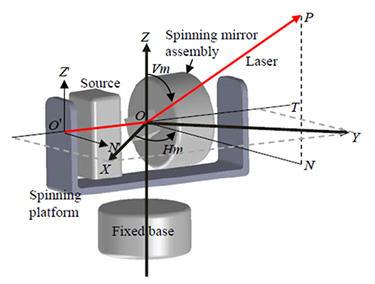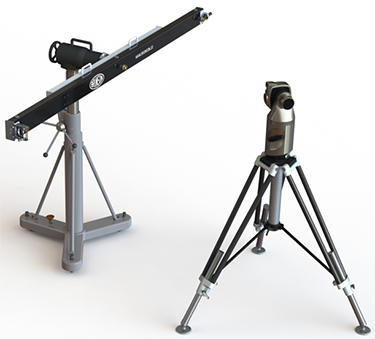Summary
The Advanced Dimensional Measurement Systems (ADMS) project provides the measurement science and infrastructure needed by industry to adopt new dimensional measurement technology. We accomplish this by investigating new measurement systems, characterizing their errors, developing and codifying instrument test methods into documentary standards, designing high accuracy dimensional artifacts, and, as needed, creating new measurement services.
Description

New dimensional measurement technologies provide significant benefits to industry such as increasing measurement throughput, enabling new manufacturing process and providing more detailed part information for manufacturing process improvement. However, before purchasing and using new measurement technology, the user must understand the capabilities and performance of the instrument. This is not a simple task and, for much of U.S. industry, can be sizable barrier to the adoption of advanced measurement systems.
The ADMS has unique assets and capabilities that we apply to these measurement challenges, including
- advanced analysis capabilities to develop sophisticated models of the measuring systems
- high accuracy testing facilities that provide industry innovators practical access to the SI unit of length
- experience developing high accuracy dimensionally stable measurement artifacts for realization of the unit of length in industrial facilities
- advanced mathematical algorithms to perform computationally complex analysis of the dense data sets provided by many advanced measuring systems.
The ADMS regularly partners with U.S. industry to develop tests for new instruments as well as to provide U.S. manufacturers of measurement equipment access to our unique facilities early in the development process, helping them shorten the time to market. Through these industrial contacts, the ADMS exchanges the vital information regarding the measurement technologies and their uncertainly sources that is critical to developing documentary standards.
Mission:

- Advance dimensional metrology by developing new test methods and first principles error correction and analysis techniques and codify these methods and techniques in national and international standards.
- Promote U.S. innovation and industrial competitiveness by developing high accuracy dimensional artifacts and new measurement services to provide measurement traceability and disseminate our institutional knowledge through collaboration on special measurement challenges and educational outreach.
Current and Future Emphasis Areas:
- Develop methods to test performance of dimensional measurement systems such as laser scanners, optical dimensional measurement systems (stereo vision systems, fringe projection systems, video-based motion capture systems), x-ray computed tomography systems, etc.
- Support the development of national and international documentary standards for above mentioned technologies.
- Provide guidance to industry on metrological traceability of data obtained from those measurement technologies.
Major Accomplishments
-

Figure 3. Artifact comprising four spheres and a contrast target to study target center errors in terrestrial laser scanner data as a function of target orientation. Credit: NISTCurrently developing a new method of uncertainty evaluation using multiple measurements on an uncalibrated workpiece along with a few measurements on simple, calibrated artifacts. This work is in support of the ongoing ISO 15530-2 standards activity. Presented the work at the NCSL conference in 2024.
- Currently working with the Organization of Scientific Area Committees for Forensic Science (OSAC) to develop a test procedure for performance evaluation of terrestrial laser scanners for use by forensic practitioners in the field. An article related to this effort is available: https://doi.org/10.3390/s25020505 (also Fig. 3).
- Currently engaged in revisions to the ASME B89.4.23 x-ray computed tomography performance evaluation standard. This standard was originally published in 2020, also with significant DMG contributions.
- Currently working with an international team within ISO to develop a test artifact for x-ray computed tomography that captures most error sources in a single simple, easy-to-calibrate, inexpensive, artifact
- 2025: Champlain Towers South collapse investigation to understand cause of building failure. Acquired nearby building data for traceability, analyzed data from optical instruments for uncertainty quantification, developed custom coordinate metrology algorithms for wall verticality study, created a novel orient-to-gravity test via puddle analysis, and performed extensive data collection. Publicity release: https://www.nist.gov/disaster-failure-studies/champlain-towers-south-collapse/background
- 2025: Explored a novel role, i.e., outlier identification, for median curves and surfaces in coordinate metrology, and developed the techniques to compute these curves and surfaces. Article available: https://doi.org/10.1115/IMECE2024-145576
- 2025: Developed a novel technique to calibrate angular positioning errors of a rotation stage using a laser tracker and a plane mirror and applied that technique to calibrate angular errors for the Retarding Field Analyzer experiment within NIST. Article available: https://doi.org/10.3390/s25061834
- 2024: Developed an artifact to assess the influence of optical properties of materials on ranging errors in terrestrial laser scanners. Presented the work at the CMSC Annual Meeting in Charlotte, NC, 2024 (Fig. 4).

- 2024: The new ISO 5459 was published with a new definition of planar datums led by DMG staff. The new definition harmonizes with the same new definition adopted by ASME (also with DMG leadership) and is more resilient to the presence of errors. The improved definition (based on several DMG publications) governs many billions of dollars of manufactured product per year. An article related to this effort is available: https://doi.org/10.1115/1.4054304
- 2024: Provided dimensional metrology to support the realization of Newtonian’s constant of gravitation using BIPM’s torsion balance. Article available: https://doi.org/10.1109/CPEM61406.2024.10646040
- 2024: Developed techniques to handle outliers within the context of ISO GPS standards. Article available: https://doi.org/10.1016/j.procir.2024.10.029
- 2024: Through simulations and experiments, assessed the efficacy of the VDI/VDE 2634-2 and ISO 10360-13 performance tests in detecting systematic errors in structured light systems. Proposed new tests that reveal these errors with higher sensitivity. Article available: https://doi.org/10.1016/j.precisioneng.2024.04.015
- 2024: Developed methods to evaluate laser tracker and terrestrial laser scanner range performance by stitching short segments so that a longer range of the instrument can be tested when the reference instrument and/or the testing facility are limiting factors. Article available: https://doi.org/10.3390/s24102960 (see Fig. 5).
-

Figure 5. Terrestrial laser scanner range evaluation by stitching over 120 m in a long corridor between buildings. The photo shows the backside of the target and the reference instrument (a laser tracker). The instrument under test, a terrestrial laser scanner, is at the far end of the corridor. Inset shows the front of the target. Credit: NIST2023: Designed, built and delivered a scale bar to the Naval Surface Warfare Center, Corona, for testing their terrestrial laser scanners internally at their facility.
- 2023: Through simulations and experiments, assessed the efficacy of the VDI/VDE 2634-1 performance tests in detecting systematic errors in passive stereo vision systems. Proposed new tests that reveal these errors with higher sensitivity. Article available: https://doi.org/10.1016/j.precisioneng.2022.11.005
- 2023: Performed an ASTM E3125-17 calibration on a prototype Dynamic 9D LADAR system for API, a manufacturer of metrology equipment. Transferred technology so that API can perform this calibration in their facility.
- 2023: Established the dual pass technique for laser tracker ranging in the tape tunnel facility. This allows the evaluation of the full 80 m range of laser trackers using just 40 m on the tape bench. Article available: https://doi.org/10.6028/NIST.IR.8468
- 2022: Explored the dimensional metrology challenges encountered while performing G measurements using the BIPM torsion balance and provided solutions. Presented this work at the 37th annual meeting of the American Society for Precision Engineering.
- 2022: Calibrated photometry bench for internal customer so that NIST can offer best-in-the-world solid-state lighting and photometer measurement services.
- 2022: Organized an online workshop funded by NIST’s International and Academic Affairs Office (IAAO) on laser trackers and terrestrial laser scanners in collaboration with CENAM. The workshop was attended by participants from eight SIM NMIs – NIST, CENAM (Mexico), NRC Canada, INMETRO (Brazil), IBMETRO (Bolivia), INACAL (Peru), INTI (Argentina), INM (Colombia).
- 2022: Acquired a new Avonix x-ray computed tomography system to support the development of national and international standards.
- 2021: Provided leadership (convener) for the ISO 10360-13: Optical 3D CMS (a new standard, not a revision) effort, integration into 10360 series philosophy, separation of error sources captured.
- 2021: Completed the revision of the ASME B89.4.19-2021 and ISO 10360-10:2021 standards on laser trackers. Standard includes performance tests designed by NIST-DMG based on mathematical error models developed here.
- 2021: Leadership of the ASME B89.4.10 – 2021 standard on Methods for Performance Evaluation of Coordinate Measuring System Software. This revision provides for testing a wider range of CMS software and paves the way for an expanded testing service (ATEP-CMS)
- 2021: Developed a network-based technique to validate laser tracker performance in cooperation with SIM NMIs. Article available: https://doi.org/10.1016/j.precisioneng.2021.07.005, publicity release: https://www.gob.mx/cenam/articulos/metrologia-dimensional-a-gran-escala?idiom=es.

